The Irish Wolfhound (Canis lupus familiaris) is a popular dog choice. Their lack of shedding and gentle nature with children makes them a great addition to a household. However, if you want to add an Irish Wolfhound to your home, you should know the health issues they are prone to. While not all Irish Wolfhounds will suffer from the ailments discussed in this article, you should be aware of them. With a lifespan of 6-10 years, you want to give your dog the best quality of life. This article will discuss the most common Irish Wolfhound health problems in detail.
Irish Wolfhound Health
The Irish Wolfhound is considered a relatively hardy dog, but their rapid growth rate makes them prone to injury. Additionally, they are prone to the typical diseases that affect larger breeds. The ailments listed below are medical problems that the Irish Wolfhound may be prone to.
1. Bloat
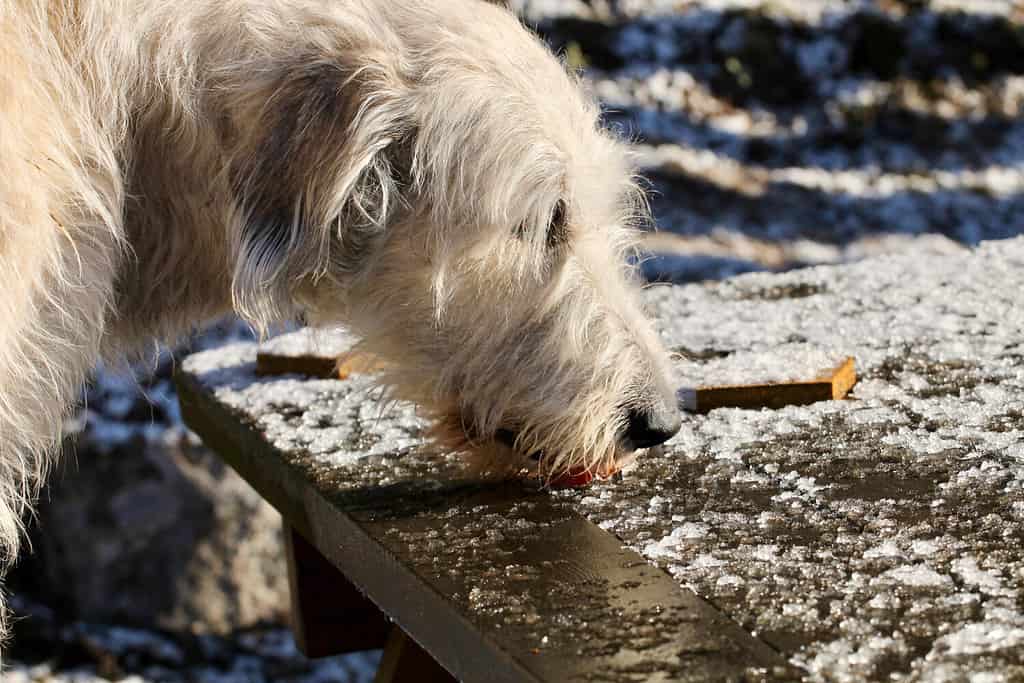
Irish Wolfhounds have very deep chests, which puts them at a greater risk of developing bloat.
©LNbjors/Shutterstock.com
This issue usually occurs in dogs with deep or narrow chests. The Irish Wolfhound has a very deep chest, putting it at risk of developing this condition. Bloat occurs when the dog’s stomach twists on itself and fills with gas. As it twists, the blood supply to the stomach, and occasionally the spleen, is cut off. Without treatment, this condition is fatal. Signs that your Irish Wolfhound may be suffering from bloat are dry heaving, acting restless, and an enlarged abdomen.
2. Cancer
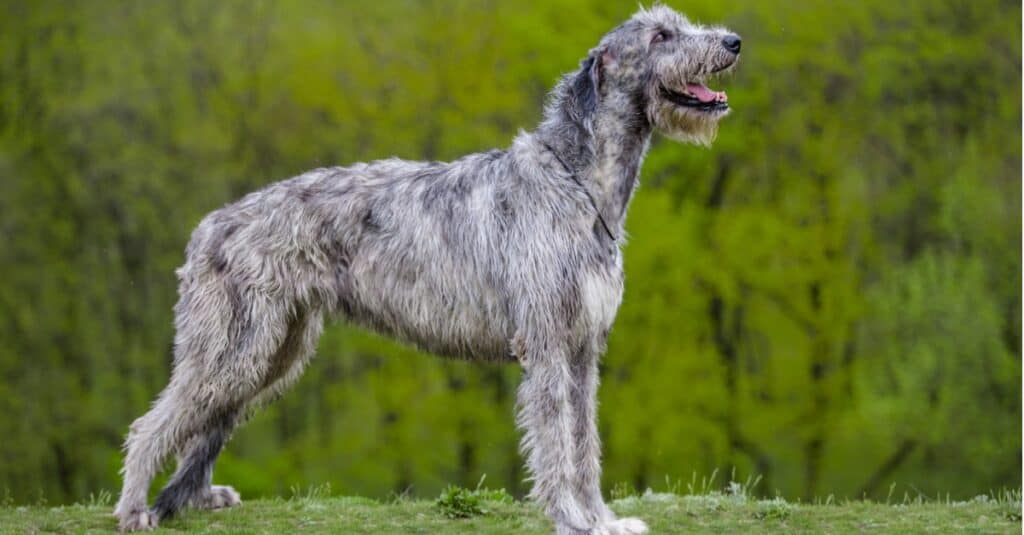
As a larger breed of dog, Irish Wolfhounds are more susceptible to osteosarcoma.
©iStock.com/Ashva
Unfortunately, all dogs are subject to potentially getting cancer in their lifetime. For the Irish Wolfhound, one of the most common cancers is osteosarcoma. Osteosarcoma is a bone tumor that primarily affects larger breeds of dogs. It typically occurs in the bones of the limbs, but it can also occur in the skull, spine, or ribcage. Treatment usually consists of surgery.
3. Elbow Dysplasia

Elbow dysplasia is the second-most common cause of elbow lameness in dogs.
©Jolanta Beinarovica/Shutterstock.com
Dysplasia is a developmental defect where abnormal cells appear in tissues or organs of the body. Dogs affected with this will have elbow lameness and will have trouble recovering from exercise. Additionally, dogs that are affected by this usually walk with their paws turned inwards. This cannot be diagnosed before the growth plate joints are finished closing. Surgery is a common solution.
4. Heart Disease
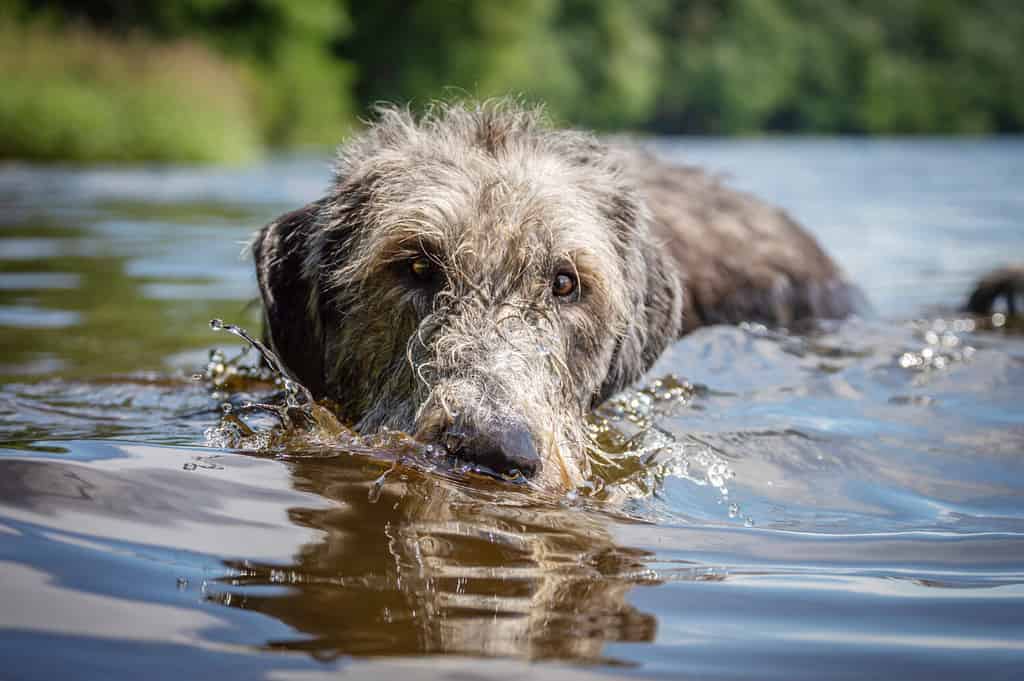
Obesity is a serious health problem that can cause or worsen conditions such as heart disease.
©84kamila/Shutterstock.com
Another common health problem for Irish Wolfhounds is heart disease. More specifically, these dogs are prone to a specific condition called cardiomyopathy. With this condition, the heart becomes too large, thin, and weak. Therefore, it cannot effectively pump blood to the rest of the body. Symptoms of this condition are weakness, collapsing, or labored breathing. Your vet can screen for this condition by looking for abnormal heart rhythms at yearly checkups. It can be helped with medication and dietary changes.
5. Liver Shunt

If your dog has a liver shunt, its liver cannot remove toxins from its bloodstream effectively.
©BORINA OLGA/Shutterstock.com
This is usually diagnosed when the dog is a puppy. Puppies should be screened for this at 8-10 weeks old. This ailment occurs when there is an abnormal connection between the portal vein and another vein, which allows blood to bypass around the liver. Common signs are stunted growth, disorientation, poor muscle development, and seizures.
6. Osteochondritis Disssecans
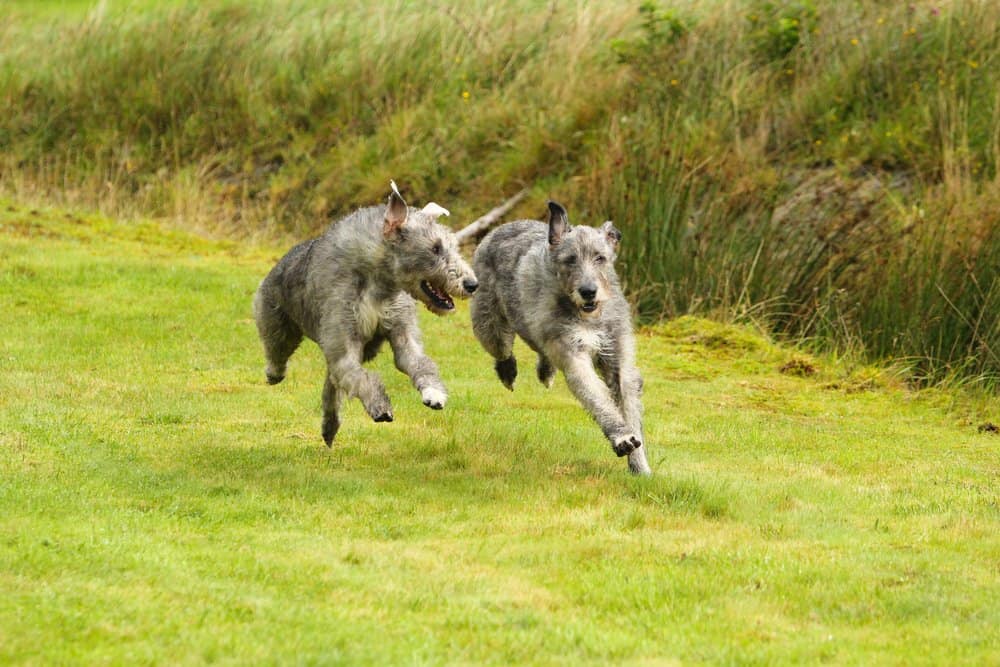
Osteochondritis dissecans occurs more often in males than females.
©Barbora Bridges/Shutterstock.com
Another common Irish Wolfhound health problem is osteochondritis dissecans (OCD). This issue occurs when puppies grow too quickly, and the cartilage in their joints does not attach to the bone properly. It more readily happens in large-breed dogs, and it occurs mostly in males. Symptoms include showing signs of limpness in the affected leg(s) and swollen joints that are warm to the touch. Rest, medications, and surgery are all recovery options depending on the dog’s age and the severity of the OCD.
7. Panosteitis
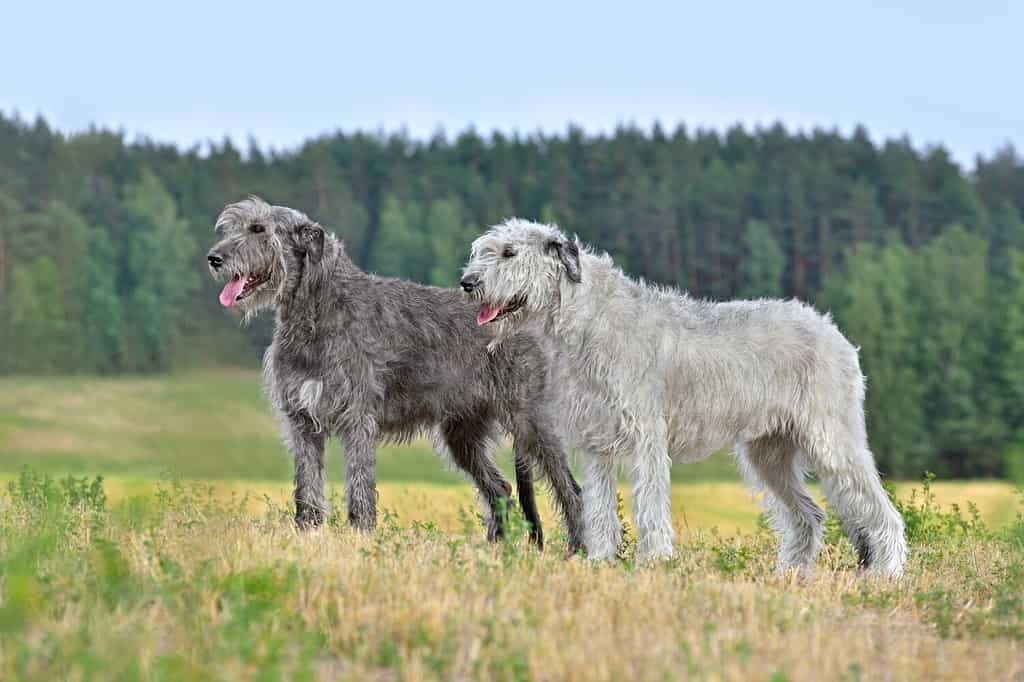
Sometimes referred to as growing pains, panosteitis will usually resolve independently.
©Natallia Yaumenenka/Shutterstock.com
Another health problem that can affect growing Irish Wolfhounds is panostetis. Panosteitis is an inflammation in the shaft of one or more long bones in the leg. It is painful and is sometimes referred to as growing pains. This issue affects young, rapidly growing dogs and is more prone to larger breeds. Most times, the issue will resolve on its own. Although it will spontaneously resolve, there are treatment options, such as anti-inflammatories or other medications, to help mitigate pain levels and assist with lameness during the time of your dog’s condition.
8. Pneumonia
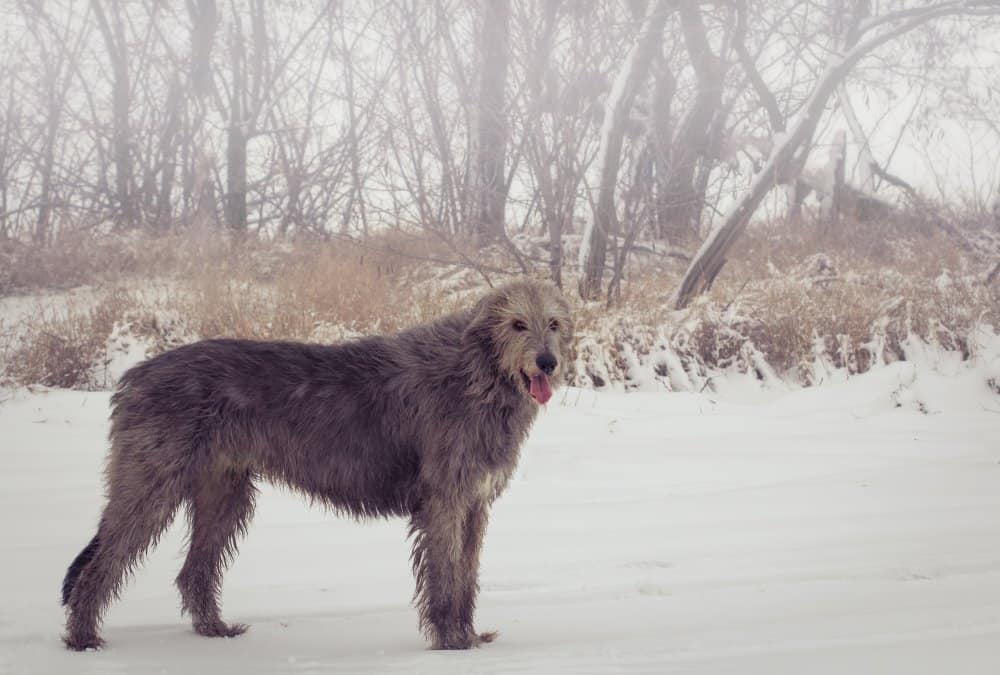
Common signs of pneumonia are breathing difficulties, coughing, wheezing, lethargy, and irregular breathing.
©Olga Salt/Shutterstock.com
Pneumonia affects your dog’s respiratory system and interferes with their ability to breathe regularly. Infectious pneumonia is the most common type, and a virus or bacteria can cause it. Common signs of pneumonia are breathing difficulties, coughing, wheezing, lethargy, and irregular breathing. It can be treated with medication.
9. Thyroid Dysfunction

Hypothyroidism is the most common type of thyroid disorder that affects Irish Wolfhounds.
©Viktoriia Bondarenko/Shutterstock.com
Another common Irish Wolfhound health problem is thyroid issues. For this breed specifically, hypothyroidism is the most common issue. Hypothyroidism is when the thyroid is underactive. In dogs, it is usually caused by lymphocytic thyroiditis or idiopathic thyroid gland atrophy. Signs that your dog may be suffering from hypothyroidism include weight gain, cold intolerance, lethargy, and slow heart rate. While this ailment cannot be cured, it can be treated with the administration of thyroid replacement hormones.
10. Von Willebrand’s Disease
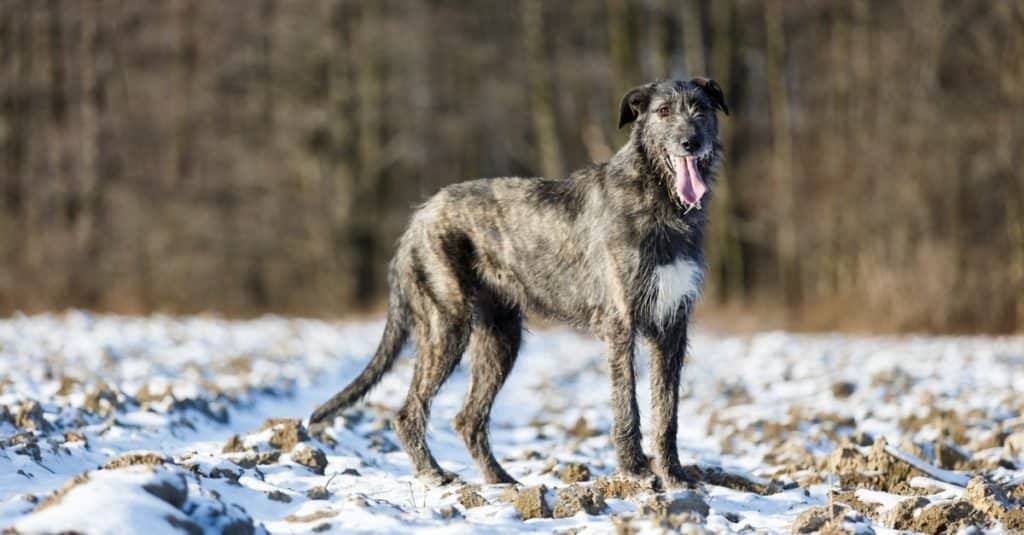
Irish Wolfhounds sometimes get Von Wilebrand’s disease, a bleeding disorder that makes it difficult for blood to clot.
©Canon Boy/Shutterstock.com
Von Willebrand’s disease is a bleeding disorder that makes it difficult for blood to clot. Signs that your dog may have this are frequent mild to severe bleeding. If the condition is severe, it can cause unprompted bleeding from the nose, mouth, or intestinal tracts. This disease has no treatment, but its symptoms can be managed.
Summary of 10 Common Irish Wolfhound Health Problems
| Health Problem | Description | Signs to look for |
|---|---|---|
| Bloat | When the dog’s stomach twists on itself, fills with gas, and cuts off the blood supply to the stomach and spleen. | Dry heaving, acting restless, an enlarged abdomen. |
| Cancer | A common cancer is osteosarcoma, which is a bone tumor. | The first signs are limpness or not using one of its legs. |
| Elbow Dysplasia | A developmental defect where abnormal cells appear in tissues or organs of the body. | Elbow lameness, difficulty recovering from exercise, walking with paws turned inward. |
| Heart Disease | Mostly prone to cardiomyopathy, where the heart becomes too large, thin, and weak to pump blood effectively. | Weakness, collapsing, labored breathing. |
| Liver Shunt | When there is an abnormal connection between the portal vein and another vein, allowing blood to bypass the liver. | Stunted growth, disorientation, poor muscle development, and seizures. |
| Osteochondritis Dissecans | Occurs when puppies grow too quickly, and the cartilage in their joints does not attach to the bone properly. | Showing limpness in the affected leg(s) and swollen joints that are warm to the touch. |
| Panosteitis | Inflammation in the shaft of one or more long bones in the leg. | Lameness in the leg. |
| Pneumonia | Infection that affects the respiratory system. | Breathing difficulty, coughing, wheezing, or lethargy. |
| Thyroid Dysfunction | Hypothyroidism is an underactive thyroid. | Weight gain, cold intolerance, lethargy, and slow heart rate. |
| Von Willebrand’s Disease | Bleeding disorder that makes it difficult for blood to clot. | Frequent mild to severe bleeding from the nose, mouth, or intestinal tract. |
The photo featured at the top of this post is © BORINA OLGA/Shutterstock.com
Thank you for reading! Have some feedback for us? Contact the AZ Animals editorial team.






